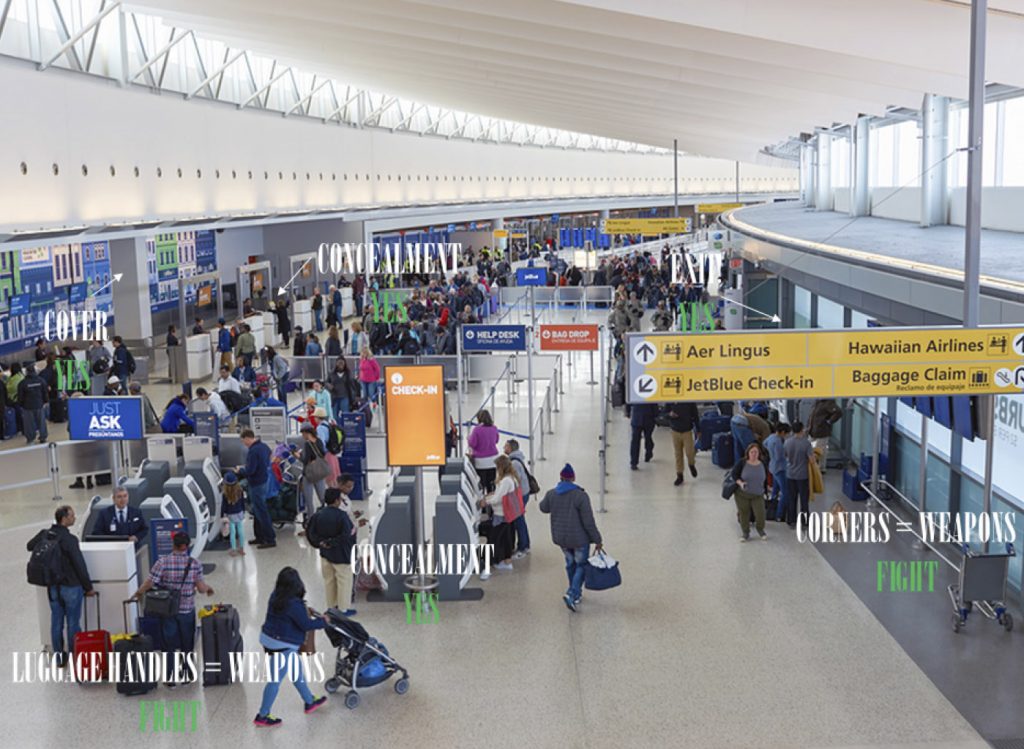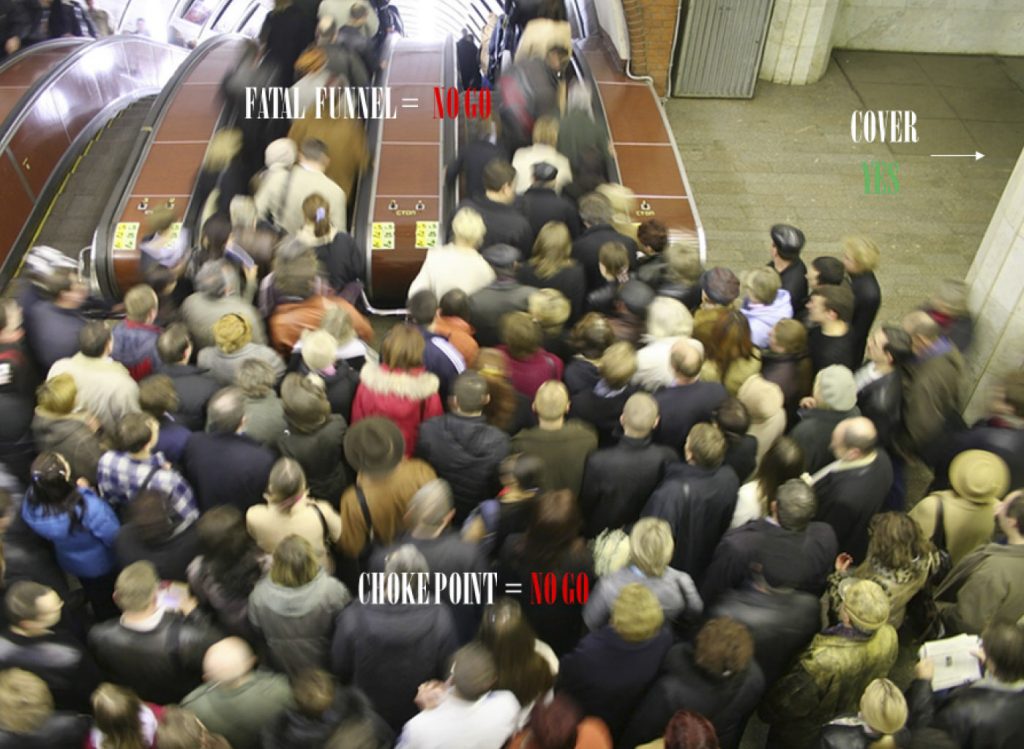When it comes to surviving sudden violence whether as the result of an active shooter or other civilian mass casualty incident, I always tell people it is more important to not get shot than it is to shoot, shooting is extra credit.
So, when you think about negotiating an airport whether domestically or abroad what is your personal readiness level? What is that of your family or client? When they look at an environment or a situation, how well do they see primary and secondary exits? Do they know how to use angles and layers to their benefit? Do they recognize cover? What could they potentially use as an improvised weapon in an emergency, since the TSAs prohibit you from carrying a weapon in the secure areas of the airport? Do they recognize the chokepoints which will restrict their movements and hinder their ability to escape? Do they know how to create their own fatal funnels to stage a controlled ambush if required?
Acts of terror and attacks at airports are not just limited to international travel as we have seen active shooters in the New York, Los Angeles and Ft. Lauderdale Airports. When I looked at video footage from the recent Ft. Lauderdale Airport shooting that killed five (5) and injured six (6) it demonstrated that most people even in the face of extreme violence have little to no tactical survival skills. As I viewed the video below please find a few of my observations:
- Most had no orientation to the direction of gunfire, even when the gunman was right in front of them.
- Many people were freezing in place. We know the three most conditioned responses to fear are fight, flight or freeze. Without training, many defaulted to the freeze response.
- People who were in the opposite direction of where the gunman was moving were attempting to take cover while exposing their backs to the direction of the gunfire.
- Very few were attempting to create distance, to help increase the difficulty of the shooter to injure or kill more innocent civilians. Particularly since most shooters don’t shoot well over distance with handguns.
- Some were laying prone on the ground attempting to take cover below the seated area, but the prone position gave them limited to no mobility with the gunman still in their immediate proximity.
- Many were attempting to hold onto their luggage as opposed to leaving it to enhance their ability to escape and increase their mobility.
- We also saw people walking with kids. This is a perfect example of why when we are in public we should keep our kids close to us, and never let them run ahead. Think how easy it could have been for kids to have been cut off from their parents during the chaos and violence.
When it comes to surviving active shooter events (ASE), it is important to understand the tactical triad of Distance, Cover and Concealment, and that they are your friends. Distance as we stated earlier increases the difficulty of the shot for the active killers.
Cover has ballistic stopping capabilities, while concealment serves to hide you from the view of the threat. For those who aren’t in protective services, law enforcement or military, they should consider taking a tactical firearm’s training class to get better oriented to gunfire, tactics to survive with or without a firearm and most importantly how to maintain situational awareness in the face of extreme and sudden violence.
Be aware of people’s activities around you even in places where there is an expectation of privacy. While I am not looking to watch someone in the restroom take a whiz, be attune to something that stands out. And don’t be afraid to contact the authorities. It is reported the Ft. Lauderdale shooter went into the men’s room and retrieved his firearm from his checked luggage and loaded it.
Despite what some may believe active shooters while they may be evil or emotionally disturbed they are not super human. In over 50% of the time the shooter is terminated, the clear majority through suicide, followed by being killed by law enforcement. Even in the absence of a gun, civilians are encouraged to take action. Thirteen percent (13%) of the time they are restrained by unarmed civilians and only 4% of the time the event is concluded by armed citizens. So, despite the political climate around CCW holder most of the time they are not on location when a ASE occurs so the impact is minimal. If you travel internationally rarely will you be able to travel with a firearm so it is important to understand protective strategies that involve unarmed countermeasures. Also since most active shooters often pick soft targets with high crowd counts and a low presence of security, going forward we should demand of our public officials a higher profile presence of law enforcement at our airports to serve as visual deterrents to potential terrorists (foreign or domestic).
Understanding the Role of the First Responder
The first response team will typically be a small unit of officers or may be a solo officer. They may be in uniform or plain clothes but will generally be identifiable as law enforcement either by uniform, badge or tactical vest. Don’t expect first responders to render first aid; their initial concern is neutralizing the threat. So initially you will be on your own. If the first responders move you to areas such as the tarmac or hangers avoid taking cover in areas that may house flammable liquids such as jet fuel. As those areas, could be boobytrapped.
International Terror
While active shooters may be responsible for the majority of civilian mass terror events in the US, the international tool of terror is explosives. Over 70% of the acts of terror committed abroad involve IEDs. So as terrorist organizations try to recruit or influence the activation of home grown terrorists our thinking around enhancing our protective capabilities must evolve.
Understanding the Istanbul Airport Terrorist Attack
When we look at the terrorist attack at the Ataturk Airport in Istanbul, Turkey in June of 2016 that killed 45 people and injured 230, we saw the terrorists incorporated the use of Hybrid Target Violence (HTV), to increase the body-count. HTV is defined as an intentional use of force to cause physical injury or death to a specifically identified population using multifaceted conventional weapons and tactics. These incidents may involve conventional weapons, the use of fire as a weapon, chemical weapons, and/or improvised explosives. The terrorist in at the Turkish airport used a combination of automatic weapons and explosive vests to create the carnage. So, the go forward challenge for protectors and travelers is to prepare for violent “hybrid” multi-threat incidents. Attacks of this nature defy conventional thinking about protection strategies involving active shooters about the role of police, fire, and emergency medical professionals. HTV events demand cooperative strategies by both officials and private security entities to efficiently neutralize complex threats that are beyond the capacity of a single first responder discipline.
IED Precautions and Takeaways
- Over 70% of all terrorist attacks outside of the US involve IEDs.
- 15 – 20 lb. range is the largest size explosive a bomber can easily carry, particularly without altering their gate.
- Be cautious of people carrying backpacks or luggage that appears heavy.
- Be cautious of people carrying backpacks in places that are not normal.
- Be cautious of abandoned luggage immediately create distance particularly in heavily trafficked public places.
- Critical stand-off distance is 15 meters (100% mortality rate inside of 5 meters).
- If you see a IED you are already too close.
- If you suspect an explosive device do not use your phone within 50 meters.
- Suicide Bombers often have handlers. The handler’s job is to protect the bomber from LE, Military or armed Civilians. We saw this at the theater in Paris.
- Suicide Bombers tend to detonate when confronted.
- Does the person you suspect as a potential bomber appear to be focused on someone or has just recently concluded a conversation with someone?
If you are in a building during an explosion, get your client or family member under some cover if debris are falling. Be attuned to a weakened structural system, be it, the floors, stairs or ceiling. Avoid using the elevators. Once outside move away from the building, glass and other potential dangers. Be conscious of a secondary blast.
If trapped under debris: Cover, Tap, Flash, Whistle. Cover your mouth and nose to avoid inhaling dangerous gases. Use your flashlight to signal your location in low light conditions or at night. Avoid unnecessary movements to limit kicking up dust which may impair your breathing. Tap on a pipe or wall to help signal your location. Use a Whistle to signal for help. The whistle will help conserve energy and the volume of the whistle is much louder than your shouting voice.
Uncontrolled Hemorrhaging
When we look at civilian terrorist attacks, uncontrolled hemorrhaging will be the highest leverage-able area that lifesaving intervention can take place in the initial moments of a terrorist attack. What medical supplies do you carry with you when you travel? What are the challenges with point of wounding care in an active shooter or suicide bomber situation? The biggest challenge is making sure the threat has been neutralized or you have gotten to a position of secure cover before treatment. If you can’t stay alive you can’t help anyone else. I dictate my supplies based on where we are going to available resources on location and the perceived risk. Most airports have first aid kits to include AEDs etc. But take a Tactical Combat Casualty Care class to learn the science behind the treatment so even in the absence of a formal first aid kit you can understand improvised tools and aids which may assist you in treating yourself or others. However, I always have an individual first aid kit (IFAK) with me at all times when traveling. In the event of a continuation of a high threat event you may have to develop a causality evacuation/movement plan.
Before a you can take action to move a patient, you must develop a rescue plan to include:
- the nearest cover
- accessing the risk to the responder and locating the closest cover -deciding how to best move the injured person to cover.
HOPE WILL NEVER BE A PROTECTIVE STRATEGY, so do whatever it takes to survive. Please take the time to get training to learn how to be your own first line of defense. The life you save may be your own.
Enhancing Your Safety and Survival at the Airport
By: Mark “Six” James CPO, EPS, CAS
Mark “Six” James is Founder and Executive Director of Panther Protection Services, LLC. He is an internationally published author, keynote speaker, security consultant to educational institutions and frequent contributor to a number of print, broadcast and online media. Panther Protection Services is a full service protection agency focusing on Risk and Crisis Mitigation, Protective Services, Self-Defense Training, and Firearm Instruction.



Leave a Reply